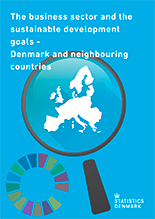Enterprises and the SDGs
The development in the business sector is of high importance for the fulfillment of the Sustainable Development Goals in Denmark. Find below a number of sustainability indicators by type of business and also reports about business and the SDGs. The indicators will currently be updated by new statistical results.
Indicators for the enterprises

















Statistical reports and analysis
Statistics Denmark now follows up on the exposition of the Danish business sector and the Sustainable Development Goals (SDGs) with a publication where we compare SDG indicators for industries in Denmark with those of seven neighbouring countries. The publication focuses on (green) transition, greenhouse gas emissions and gender equality. It illustrates the development from 2010-2019. The publication was pulished in May 2022.
Publication on the Danish business sector and the SDGs 2020
This publication shows the development since 2010 in the Danish business sector’s contribution to the Sustainable Development Goals by means of existing statistics. Following fourteen industrial groups, it gives an account of economic, environmental and social conditions. The publication was published in October 2020.
Pilot survey 2019
In 2019 Statistics Denmark asked all larger Danish enterprises about their work with the Sustainable Development Goals, including selected targets.

